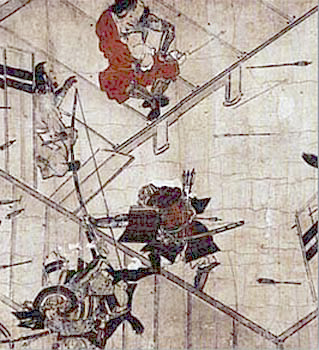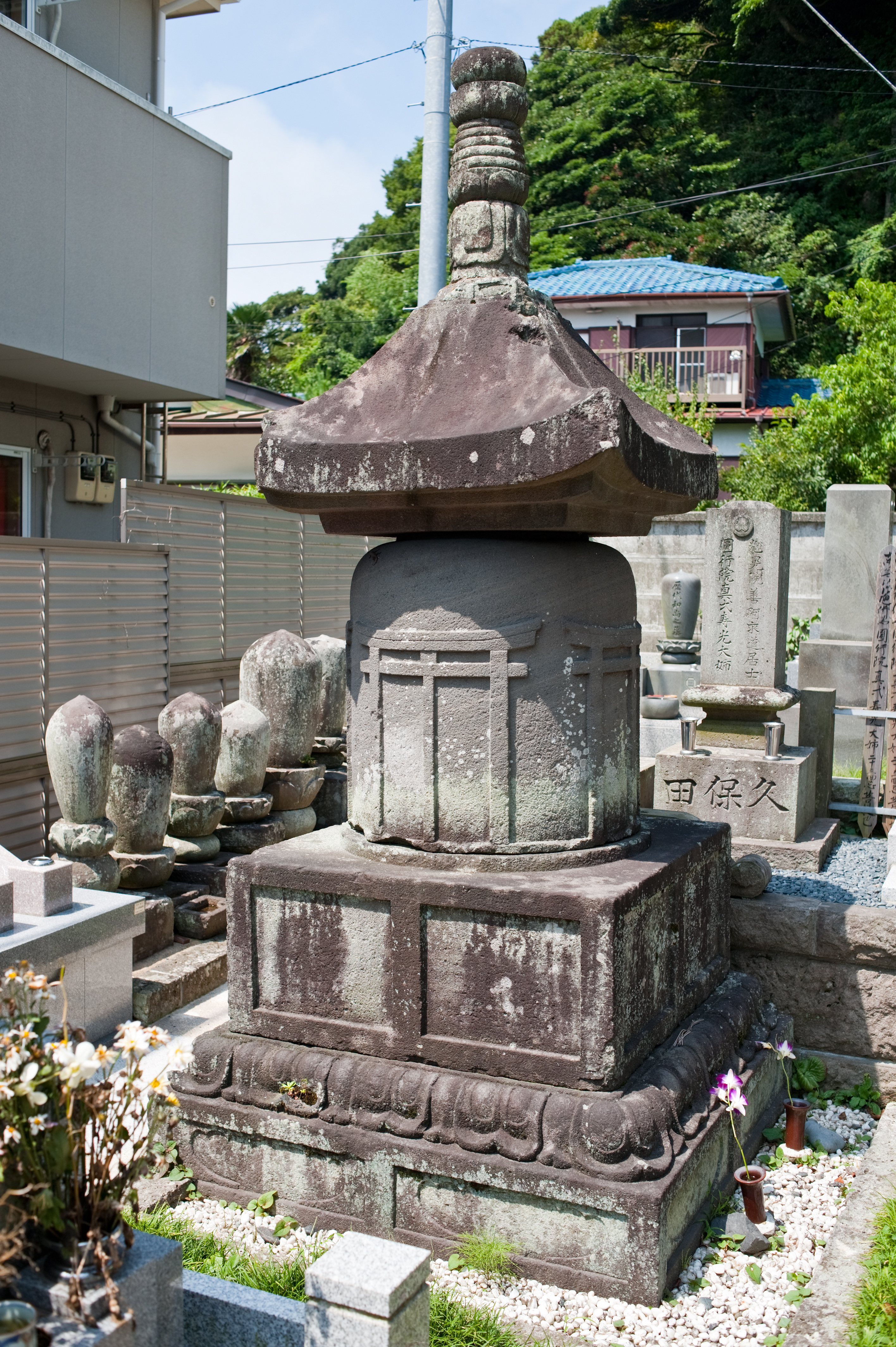Ashikaga Mochiuji on:
[Wikipedia]
[Google]
[Amazon]
 Ashikaga Mochiuji (, 1398–1439) was the
Ashikaga Mochiuji (, 1398–1439) was the
 The road that in Kamakura turns right before
The road that in Kamakura turns right before History of Kamakura (3) – Ashikaga Era
Kamakura Today, accessed on July 25, 2009 His three younger sons however escaped to
 Ashikaga Mochiuji (, 1398–1439) was the
Ashikaga Mochiuji (, 1398–1439) was the Kamakura-fu
The or was a regional government installed in Kamakura, in today's Kanagawa Prefecture, by the Ashikaga shogunate which lasted from 1349 to 1455. It was headed by a dynasty of Ashikaga rulers called ''Kamakura Kubō'' (or ''Kantō Kubō''). The ...
's fourth Kantō kubō
(also called , , or ) was a title equivalent to ''shōgun'' assumed by Ashikaga Motouji after his nomination to ''Kantō kanrei'', or deputy shōgun for the Kamakura-fu, in 1349.Kokushi Daijiten (1983:542) Motouji transferred his original title t ...
during the Sengoku period
The was a period in History of Japan, Japanese history of near-constant civil war and social upheaval from 1467 to 1615.
The Sengoku period was initiated by the Ōnin War in 1467 which collapsed the Feudalism, feudal system of Japan under the ...
(15th century) in Japan. During his long and troubled rule the relationship between the west and the east of the country reached an all-time low. Kamakura was finally attacked by ''shōgun'' Ashikaga Yoshinori
was the sixth ''shōgun'' of the Ashikaga shogunate who reigned from 1429 to 1441 during the Muromachi period of Japan. Yoshinori was the son of the third ''shōgun'' Ashikaga Yoshimitsu.
Titsingh, Isaac. (1834). His childhood name was Harutor ...
and retaken by force. Mochiuji and his eldest son Yoshihisa killed themselves to escape capture.
Biography
Mochiuji became ''Kubō'' while still a child after his father died suddenly of a disease. His violent and abrasive character from the beginning caused widespread resentment among his vassals. After disagreements with Mochiuji, his ''kanrei
or, more rarely, ''kanryō'', was a high political post in feudal Japan; it is usually translated as ''shōguns deputy''. After 1349, there were actually two ''Kanrei'', the ''Kyoto Kanrei'' and the ''Kantō Kanrei''.
Originally, from 1219 until ...
'' Uesugi Zenshū
, also known as Uesugi Ujinori, was the chief advisor to Ashikaga Mochiuji, an enemy of the Ashikaga shogunate in feudal Japan. When he was rebuked by Mochiuji in 1415, and forced to resign, Zenshū organized a rebellion.
Zenshū received aid f ...
organized a rebellion against him (the so-called ''Zenshū no Ran'') with the aid of nearly half the ''daimyō
were powerful Japanese magnates, feudal lords who, from the 10th century to the early Meiji era, Meiji period in the middle 19th century, ruled most of Japan from their vast, hereditary land holdings. They were subordinate to the shogun and n ...
s'' in the northern and eastern provinces. Thanks to this support, Zenshū could take Kamakura and Mochiuji had to flee. However, despite his pursuing goals similar to those of the shogunate, Zenshū was after all rebelling against his lord, so the shogunate had no choice but to send troops to stop him. In 1417, Zenshū and his allies found themselves surrounded at Tsurugaoka Hachimangū
is the most important Shinto shrine in the city of Kamakura, Kanagawa Prefecture, Japan. The shrine is a cultural center of the city of Kamakura and serves as the venue of many of its most important festivals with two museums.
For most of its ...
and Zenshū killed himself.
After this took place, Mochiuji attacked Zenshū's allies, which included families as the Oda and the Takeda
is a Japanese family name.1990 Census Name Files< ...
, along with a few noble families from Musashi Province
was a province of Japan, which today comprises Tokyo Metropolis, most of Saitama Prefecture and part of Kanagawa Prefecture. It was sometimes called . The province encompassed Kawasaki and Yokohama. Musashi bordered on Kai, Kōzuke, Sagami, S ...
. The Ashikaga themselves thought Mochiuji's actions to be too much, and ''shōgun'' Ashikaga Yoshinori
was the sixth ''shōgun'' of the Ashikaga shogunate who reigned from 1429 to 1441 during the Muromachi period of Japan. Yoshinori was the son of the third ''shōgun'' Ashikaga Yoshimitsu.
Titsingh, Isaac. (1834). His childhood name was Harutor ...
in 1432 ordered his army to destroy Mochiuji. This led to Mochiuji and Yoshinori to battle it out during the Eikyō Rebellion
was a after ''Shōchō'' and before '' Kakitsu''. This period spanned the years from September 1429 through February 1441. The reigning emperor was .
Change of era
* 1429 : The era name was changed to mark the beginning of the reign of Empero ...
in 1438. In the end, Yoshinori successfully put an end to Mochiuji's rebellion in 1439. Kamakura's ''Kubō'' committed seppuku at the temple of Yōan-ji, west of the city. The events in Kamakura however caused widespread resentment among Yoshinori's generals and one of them, Akamatsu Mitsusuke
was a Japanese samurai of the Akamatsu clan during the Muromachi Period. Nussbaum, Louis-Frédéric. (2005) "''Kaikitsu-no-hen,''"''Japan encyclopedia,'' p. 456.
Early life
Mitsusuke was the son of Akamatusu Yoshinori.
Assassin
In 1441, Mi ...
, murdered him in revenge.
Yōan-ji
 The road that in Kamakura turns right before
The road that in Kamakura turns right before Zuisen-ji
is a Buddhist temple of the Rinzai sect in Nikaidō's in Kamakura, Japan.Kamiya (2008:98-102) During the Muromachi period it was the family temple of the Ashikaga rulers of Kamakura (the ''Kantō kubō''): four of the five ''kubō'' are burie ...
's ticket counter leads to a stele marking the spot where used to stand.Kamiya (2008:98-102) It was here that Mochiuji made his last stand against the shogunate, finally disemboweling himself to avoid the shame of being taken prisoner He is buried together with three other ''kubō'' in a small cemetery within Zuisen-ji (closed to the public). The stele reads:
When ''Kantō Kubō''There is however also a 3.2 m stone traditionally supposed to be his grave also at Betsugan-ji, a former Ashikaga family temple in Ōmachi. On the stupa is carved the date 1439, the year of Mochiuji's death, however the tomb seems stylistically to belong rather to the precedentAshikaga Ujimitsu (1359–1398) was a Nanboku-chō period warrior and the Kamakura-fu's second ''Kantō kubō'', or ''Shōgun'' Deputy. Son of first ''Kantō Kubō'' Ashikaga Motouji, he succeeded his father in 1367 at the age of nine when this last suddenly died ...died on January 11, 1398, he was given theposthumous name A posthumous name is an honorary name given mostly to the notable dead in East Asian culture. It is predominantly practiced in East Asian countries such as China, Korea, Vietnam, Japan, and Thailand. Reflecting on the person's accomplishments or .... His son Mitsukane built this temple and gave it his father's posthumous name. The temple's ''oshō is a Buddhist priest (in charge of a temple);''Kenkyusha's New Japanese-English Dictionary'', Tokyo 1991, honorific title of preceptor or high priest (especially in Zen or Pure Land Buddhism). The same kanji are also pronounced ''kashō'' as a ...'' Dombo Ushūō was a follower ofMusō Soseki was a Rinzai Zen, Zen Buddhist monk and teacher, and a calligraphist, poet and garden designer. The most famous monk of his time, he is also known as ("national Zen teacher"), an honorific conferred on him by Emperor Go-Daigo.''Musō Soseki'' .... On March 24, 1439, ''Kubō'' Mochiuji, a descendant of Ujimitsu, fought here against ''shōgun'' Yoshinori, was defeated and disemboweled himself. The temple was burned and never rebuilt. This is where it stood.
Erected by the Kamakuramachi Seinendan in March 1926
Kamakura period
The is a period of Japanese history that marks the governance by the Kamakura shogunate, officially established in 1192 in Kamakura by the first ''shōgun'' Minamoto no Yoritomo after the conclusion of the Genpei War, which saw the struggle bet ...
, and the attribution seems therefore dubious.
Mochiuji's eldest son Yoshihisa, 14 years old at the time, was also forced to kill himself at nearby Hōkoku-ji.Kamakura Today, accessed on July 25, 2009 His three younger sons however escaped to
Nikkō
is a city located in Tochigi Prefecture, Japan. , the city had an estimated population of 80,239 in 36,531 households, and a population density of 55 persons per km2. The total area of the city is . It is a popular destination for Japanese and ...
and in 1440 were led by Yūki Ujitomo, head of the Yūki clan
is a Japanese samurai kin group. Papinot, Jacques Edmond Joseph. (1906). ''Dictionnaire d’histoire et de géographie du Japon''; Papinot, (2003)"Yūki," ''Nobiliare du Japon'', pp. 71–72 retrieved 2013-5-6.
History
The Yūki claim descent fr ...
, to his castle in Koga, Shimōsa Province
was a province of Japan in the area modern Chiba Prefecture, and Ibaraki Prefecture. Nussbaum, Louis-Frédéric. (2005). "''Shimōsa''" in . It lies to the north of the Bōsō Peninsula (房総半島), whose name takes its first ''kanji'' from ...
, and survived.Papinot (1972:37-38) When later his castle was attacked by the shogunate, they escaped. Two, Haruō-maru and Yasuō-maru, were caught and executed. The lone survivor, Mochiuji's fourth child Shigeuji, would later become the last ''Kantō kubō''.
See also
*Kantō kubō
(also called , , or ) was a title equivalent to ''shōgun'' assumed by Ashikaga Motouji after his nomination to ''Kantō kanrei'', or deputy shōgun for the Kamakura-fu, in 1349.Kokushi Daijiten (1983:542) Motouji transferred his original title t ...
* Kamakura – The Muromachi and Edo periods
*Uesugi Zenshū
, also known as Uesugi Ujinori, was the chief advisor to Ashikaga Mochiuji, an enemy of the Ashikaga shogunate in feudal Japan. When he was rebuked by Mochiuji in 1415, and forced to resign, Zenshū organized a rebellion.
Zenshū received aid f ...
Notes
References
* * Papinot, E. (1910). "Historical and Geographical Dictionary of Japan." 1972 Printing. Charles E. Tuttle Company, Tokyo, . * {{Authority control Mochiuji 1398 births 1439 deaths People of Sengoku-period Japan Mochiuji 1430s in Japan 15th-century Japanese people